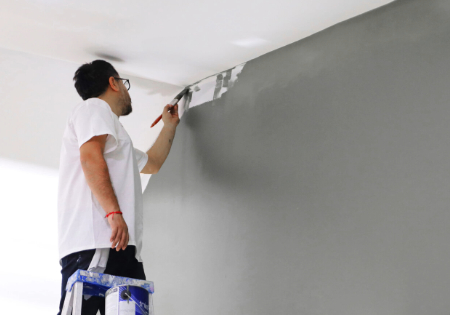Infuse Color and Style into Your Home with Paints from corpus christi tx paint shop
Checking Out the Different Kinds Of Paint: A Guide for every single Job
Exploring the different sorts of paint is important for attaining the wanted outcome in any task. From water-based alternatives that provide benefit to oil-based paints understood for their durability, each selection has its advantages. Specialty paints can include unique textures or surfaces, while environmentally friendly options provide to those seeking sustainability. Comprehending these differences can substantially affect the success of a paint undertaking. What aspects should one consider when making the ideal choice?
Comprehending Paint Kinds: Oil-Based vs. water-based
Paint types can noticeably impact a job's end result, and recognizing the distinctions between oil-based and water-based paints is vital for notified decision-making. Water-based paints, frequently referred to as latex paints, are composed of water as the key solvent. They dry rapidly, send out fewer unpredictable natural substances (VOCs), and are easy to tidy up with soap and water. This makes them a prominent option for interior applications and atmospheres where air quality is a problem.
On the other hand, oil-based paints use natural solvents, providing a durable, glossy finish suitable for surface areas revealed to put on and tear, such as trim and closets. They take longer to dry, require mineral spirits for clean-up, and have a more powerful odor. benjamin moore paint store corpus christi. Picking in between these two kinds relies on the particular requirements of the project, thinking about elements such as preferred surface, application atmosphere, and ease of upkeep. Each type has unique benefits and limitations, directing the choice procedure
The Complete Issues: Picking Between Matte, Satin, and Gloss
When selecting a paint coating, the selection between matte and shiny options significantly affects both aesthetic appeals and capability. Matte surfaces use a subtle, non-reflective look that can hide surface area imperfections, while glossy surfaces supply sturdiness and simplicity of cleaning. Understanding the benefits and factors to consider of each can assist in making a notified choice for any type of paint project.
Matte Complete Advantages
Although many homeowners debate the merits of various coatings, matte paint offers distinct advantages that make it a prominent choice for both indoor and outside applications. One of the key advantages of matte finish is its capacity to hide surface area flaws, creating a smoother look on wall surfaces. This quality is specifically advantageous in older homes or rooms with uneven surfaces. Additionally, matte paint absorbs light instead of reflecting it, which can boost the aesthetic of an area by offering a much more soft and sophisticated look. Matte surfaces are typically much easier to touch up than glossier alternatives, as they can blend extra flawlessly when used over existing paint. On the whole, matte paint is an exceptional option for those seeking a refined and elegant finish.
Shiny End Up Considerations
A shiny coating can substantially change the perception of a room, offering a sleek and reflective high quality that improves both shade vibrancy and light within a room. This finish is often preferred for high-traffic locations and surface areas like cooking areas and restrooms, where durability and simplicity of cleansing are essential. Its reflective nature can highlight flaws on wall surfaces, making correct surface area prep work essential. Glossy paints also tend to show smudges and fingerprints quicker, necessitating routine maintenance. Furthermore, illumination plays a considerable duty; in intense settings, a shiny coating might produce glare, influencing the overall aesthetic. As a result, mindful consideration of the certain application and environment is important when choosing a shiny surface for any type of project.
Specialty Paints: When to Use Textured or Chalk Paint
Specialty paints, such as textured and chalk paint, offer one-of-a-kind aesthetic and functional benefits that can enhance numerous surface areas. Textured paint is ideal for creating deepness and dimension on walls, concealing flaws while adding a three-dimensional feel. It is especially beneficial in high-traffic locations where sturdiness and aesthetic passion are necessary.

Both kinds of specialized paints can change rooms, however choosing the right one depends on the wanted impact and surface requirements. Distinctive paint might suit bigger locations, while chalk paint can rejuvenate smaller things, showcasing creative thinking and personal design in any type of job.
Outside Paints: Shielding Your Surfaces From the Elements
Outside paints are crucial for guarding surfaces versus different weather conditions. Comprehending their weather condition resistance functions, proper surface area prep work requirements, and effective application strategies can substantially improve longevity and performance. This area will outline crucial considerations for choose and utilizing exterior paints successfully.
Weather Resistance Includes
Weather condition resistance is an important attribute of outside paints, as it determines exactly how well surface areas can stand up to the harsh aspects of nature. High-quality exterior paints are formulated to stand up to damage from UV rays, moisture, and temperature level changes. UV resistance guarantees shades remain lively in time, protecting against fading and discoloration. Moisture resistance secures versus mold and mildew, which can endanger the honesty of surfaces. get more info Additionally, paints with superb temperature level resistance can expand and acquire without cracking, preserving their safety top qualities. When picking outdoor paints, it is important to take into consideration these climate resistance functions, as they add to the long life and sturdiness of coloured surface areas, ensuring they remain aesthetically pleasing and practical in spite of direct exposure to the components.
Surface Area Prep Work Needs
Appropriate surface prep work is a basic step in achieving the most effective results with exterior paints. To assure perfect attachment and sturdiness, surfaces must be extensively cleansed, eliminating dirt, mold, and oil. This can be accomplished making use of a stress washing machine or a scrub brush with an appropriate cleaning service. Once cleansed, surface areas need to be evaluated for any kind of peeling or flaking paint, which have to be scratched away to create a smooth structure. Repairing any kind of openings or fractures is likewise necessary, as these can enable dampness seepage. Furthermore, fining sand harsh locations promotes better paint attachment. Using a primer matched for outside use can boost the paint's efficiency, guaranteeing a durable surface that withstands the components. Appropriate preparation is vital to a successful outdoor paint project.
Application Strategies Tips
While applying exterior paints, it is necessary to use efficient methods that ensure surface areas are well-protected versus the aspects. Initially, choose the right day for painting; low moisture and mild temperature levels enhance attachment and drying. Prepping the surface extensively-- cleaning, fining sand, and priming-- makes sure better paint bond and toughness. Utilizing high-grade brushes or rollers can offer a smoother surface, while spray paint may cover huge locations successfully. Using paint in thin, even layers avoids drips and runs. It is suggested to follow manufacturer guidelines relating to drying times in between coats. Validate appropriate air flow throughout application to promote drying and reduce exposure to fumes. These techniques significantly improve the long life and effectiveness of exterior paint.
Eco-Friendly Options: Low-VOC and Zero-VOC Paints
As customers end up being significantly mindful of the ecological influence of their selections, low-VOC and zero-VOC paints have emerged as popular alternatives. These paints are formulated to include fewer volatile organic compounds (VOCs), which are chemicals that can vaporize into the air and add to air contamination and wellness issues. Low-VOC paints generally include a restricted quantity of VOCs, while zero-VOC paints have minimal levels, making them more secure for both outdoor and interior use.
The benefits of making use of zero-voc and low-voc paints prolong beyond ecological factors to consider; they likewise improve interior air high quality, minimizing the danger of breathing concerns and allergies. Lots of manufacturers currently supply a selection of shades and finishes in environment-friendly options, making it simpler for customers to discover suitable items for their jobs. By choosing these paints, individuals can add to a healthier environment while still attaining the aesthetic they want in their areas.
Tools and Techniques for a Remarkable Application
Achieving a flawless paint application needs the right tools and strategies, which can substantially boost the result. Selecting the proper brush or roller is necessary; brushes work well for edges and detailed areas, while rollers cover bigger surface areas efficiently. Utilizing top quality materials guarantees much better paint circulation and lessens touches. For optimal results, surface area preparation is necessary. This includes cleansing, fining sand, and priming surfaces to promote attachment.
Technique likewise plays a significant role. The "W" approach with a roller helps to evenly distribute paint, while long, smooth strokes with a brush stop noticeable lines. Operating in areas permits for much better control and blending. In addition, applying thin layers is preferable to thick layers, decreasing the risk of drips and irregular appearances. Ultimately, maintaining a wet side throughout application aids accomplish smooth modifications in between areas. By combining these methods and tools, one can accomplish a specialist and polished finish.
Tips for Maintaining and Caring for Your Painted Surfaces
Correct upkeep and treatment of coloured surfaces can significantly prolong their life-span and maintain their look. Regular cleansing is important; using a soft towel or sponge with light soap and water can eliminate dust and dirt without harming the paint. It is suggested to stay clear of rough cleansers or scrubbing pads, as these can scrape the surface. In addition, using a fresh coat of paint every few years can shield and renew the shade versus wear.
For outside surfaces, inspecting for indicators of peeling off or fading consistently is necessary. Immediately attending to any concerns avoids further damages. In locations prone to dampness, such as restrooms, using mold-resistant paint and making certain appropriate air flow can assist maintain the integrity of the paint. Ultimately, using safety surfaces can secure against UV rays and discolorations, guaranteeing that repainted surfaces continue to be lively and enticing for years ahead, inevitably boosting the overall aesthetic of the room.
Often Asked Inquiries
Can I Mix Different Kind Of Paint With Each Other?
Mixing various kinds of paint is typically not recommended, as it can bring about problems like bad bond, inconsistent appearance, or unforeseen chemical reactions. It's ideal to utilize suitable paints for ideal outcomes and toughness.

Exactly how Do I Effectively Shop Extra Paint?
To appropriately keep leftover paint, seal the container firmly, label it with the day and shade, and maintain it in an amazing, dry area away from direct sunlight and extreme temperatures for suitable conservation.
What Is the very best Way to Get Rid Of Extra Paint?
The ideal way to get rid of extra paint is to inspect local regulations, as several locations have designated contaminated materials centers. Think about donating useful paint to community organizations or colleges for their projects.
Just How Can I Inform if Paint Is Still Good to Make Use Of?
To determine if paint is still excellent, examine its color, smell, and consistency. If it shows up separated, has an undesirable odor, or reveals significant adjustments in structure, it's most likely no more useful.
Are There Age Restrictions for Investing In Paint Products?
In numerous regions, there are no details age limitations for purchasing paint products. Some stores might need customers to be at least 18 years old, specifically for products having solvents or dangerous products.
Paint types can considerably influence a job's end result, and comprehending the distinctions between oil-based and water-based paints is necessary for informed decision-making. Water-based paints, often referred to as latex paints, are made up of water as the key solvent. In contrast, oil-based paints make use of organic solvents, supplying a durable, glossy coating ideal for surfaces revealed to tear and use, such as trim and closets. Specialty paints, such as textured and chalk paint, deal distinct aesthetic and functional advantages that can enhance different surface areas. In locations prone to wetness, such as washrooms, using mold-resistant paint and ensuring proper air flow can assist preserve the integrity of the paint.